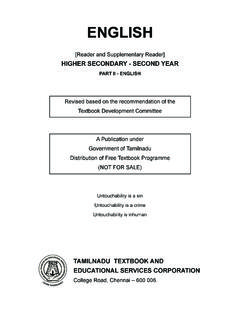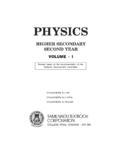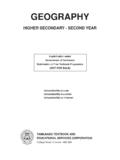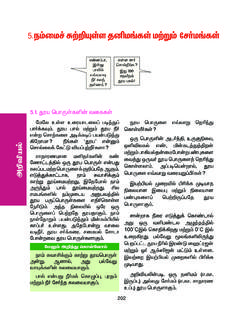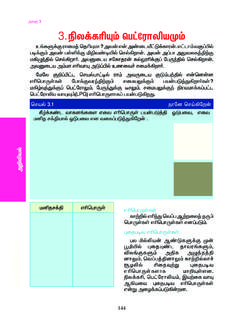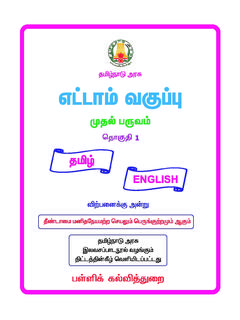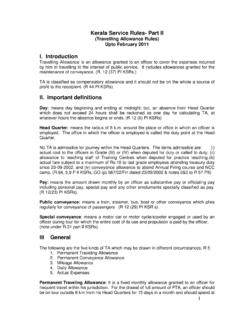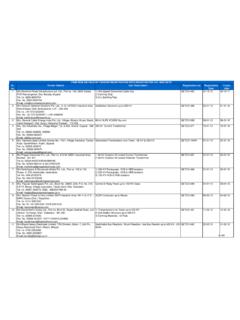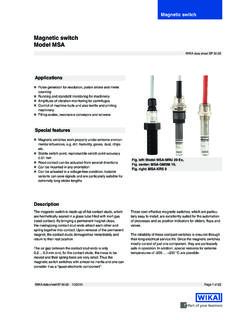Transcription of Untitled-1 - pdfMachine from Broadgun Software, …
1 MICROBIOLOGYH igher secondary - Second yearUntouchability is a sinUntouchability is a crimeUntouchability is inhumanTAM IL NADUTEXT BOOK CORPORATIONCOLLEGE ROAD, CHENNAI-600 006id54322750 pdfMachine by Broadgun Software - a great PDF writer! - a great PDF creator! - ContentsPageSection I - General of of and II - Environmental, food and Industrial III - Medical attributes of flora of the Clostridium Government of Tamilnadu First Edition- 2005 CHAIRPERSON AND AUTHORDr. T. Sundararaj,Professor and Head, Department of Post Graduate Institute of Basic Medical SciencesUniversity of Madras, Taramani, Chennai 600 113 AUTHORSDr.
2 S. Anthoniraj,Dean, Anbil Dharmalingam Agricultural Collegeand Research Institute,Trichy-620 009Dr. N. Kannan,Director, School of Biotechnology,KSR College of Technology,Thokkavadi, Thiruchengode - 637 209Dr. Muthukaruppan,Professor, Department of Microbiology,Faculty of Agriculture,Annamalai Nagar- 608002 Mrs. Aswathy Sundararaj,Lecturer in Microbiology,Tamilnadu College of PhysiotherapyInjambakkam, Chennai - 600 041 Price: book has been prepared by the Directorate of SchoolEducation on behalf of the Government of TamilnaduThis book has been printed on 60 gsm paperivSection IV -Medical Parasitology, Mycology, Virology & V - of cells in and antigen VI -- Microbial I -- II -- III -- IV -- V -- VI -- - IGENERAL MICROBIOLOGYC hapter - 1 THEORY OF BIOGENESISB iogenesis (Gr.)
3 Bio-life; genesis: orgin)means that life originatesfrom pre existing life. This denotes that life does not arise spontane-ously or created from inanimate, and abiotic objects by God. Biogen-esis involves parental organisms similar to the one formed. On the otherhand Abiogenesis or the Spontaneous generation theory suggeststhat life originates spontaneously from dissimilar inanimate objects men out of superstition, ignorance and due to fear sur-rounding the life believed that living organisms were created by Greek mythology it was believed that Goddess Gaea created peoplefrom stones and other inanimate objects. It was also a belief that ani-mals originated spontaneously from the soil, plants or other unlike ani-mals.
4 Aristotle (384-322BC), the great philosopher also taught thesame. There were also others who advocated artificial propagation ofbees based on the observation that meat exposed to warmth and airproduced maggots. Recepies were also recommended for the manu-facture of mice by putting some wheat grains, soiled linens and cheeseinto a receptacle and leaving it undisturbed. In reality the mice werenot produced but attracted by the food. There were also intelligent andthoughtful men who doubted the spontaneous generation theory (Abio-genesis) and consequently there started a controversy over the originof the creation of man from stones was discarded, theappearance of maggots and worms in exposed food material remainedunexplained.
5 Francisco Redi(1626-1697) demonstrated by coveringthe meat in a jar by a gauze, the flies attracted by the odourlaid eggs on gauze and maggots did not appear in the meat underneathclearly showing that the origin of maggots in exposed meat was due toflies. But still some people believed that tiny microbes developing inmeat originated spontaneously. John Needham(1749) exposed meatto hot ashes and found the appearance of bacteria which were notpresent originally and therefore concluded that bacteria originated frommeat. During the same time Lazarro Spallanzani showed that whenbeef broth was boiled for an hour and if flasks were sealed after boilingand incubated no microbes appeared.
6 This evidence failed to convinceNeedham who argued that air, essential for the spontaneous origin ofmicrobes was excluded by sealing of flasks and therefore no life ap-peared. This was answered after 60-70 years independently whenFranz schulze(1815-1873) passed the air through strong acid solutionand Theodore Schwann (1810-1882), passed air through red hot tubesbefore letting it into the infusions. Microbes did not appear in theinfusions in both the cases. It was argued that acid and heat de-stroyed the vital force in air and hence did not support growth. Schroderand von Dusch(1850) passed air through cotton into heated broth inflask in which no microbes appeared.
7 The microbes present in airwere filtered out by the cotton and hence no growth occurred. Thusappeared the use of cotton plug in microbiological Van Leeuwenhoek and his Microscopes:Anton van Leeuwenhoek (1632 1723) a contemporary ofRobert Hook was born in Delft, Holland. Leeuwenhoek was a suc-cessful businessman and qualified himself as a surveyor and the officialwine taster of Delft, Holland and in 1660 he was appointed chamberlane to chief judge, the sheriff s and the law officers of the city of held the position for thirty-nine years. He had little formal educa-tion and never attended a university. He was ignorant of any languageexcept Dutch. He was fortunate that his work was recognized in hislifetime itself.
8 A society for scientific work publication was establishedin England and was called as Royal society. The society invitedLeeuwenhoek to communicate his observation to its members. Hewas elected as a fellow of the society in 1680. For almost fifty yearsuntil his death in 1723, Leeuwenhoek transmitted his discoveries to the2 1id4875062 pdfMachine by Broadgun Software - a great PDF writer! - a great PDF creator! - royal society in the form of long letters written in Dutch. Most of hisdiscoveries were translated and published in English in the proceedingsof the royal society. Leeuwenhoek made glass lenses by grinding andmounting them into brass contraptions and he called them as micro-scopes and almost spherical lens (a) was mounted between two smallmetal plates.
9 The specimen was placed on the adjustable needle mountedabove the lens. The needle is a blunt pin (b) and was brought into focusby manipulating two screws (c) and (d) (figure 1).No change of mag-nification was possible and the magnifying power of each microscopebeing an intrinsic property of its 1-1. Drawings of a microscope used by Anton van LeeuwenhockHe was able to view the specimens on the blunt pin by holdingthe microscope very close to his eye and squinted through the lens. Hismicroscope was able to magnify from about 50 to 300 constructed hundreds of such instruments. Microscopywas a fascinating hobby for Leeuwenhoek and he spent greater part ofhis life making microscopes, observing the microscopic world and main-tained records of his observations in simple language.
10 He made obser-vations on the structure of seed and embryos of plants, small inverte-brate animals, spermatozoa and Red blood his greatest discovery is of the microbial world of ani-malcules. He sent the 18th letter to the society on October 9, 1676and gave the first description of unicellular animals such as protozoaand the smaller microorganisms such as bacteria. He had looked atwater samples from fresh water from river, well water, rainwater descriptions were accurate. One of Leeuwenhoek s mostpublicized observations was of bacteria from the human mouth (figure).He described rod shaped bacteria as bacilli, spherical bacteria as cocciand bacteria with spiral body that resemble cork screws as in the 1670s Leeuwenhoek wrote numerous letters to the Royalsociety in London and continued his studies until his death in 1723 atthe age of 1-2.
